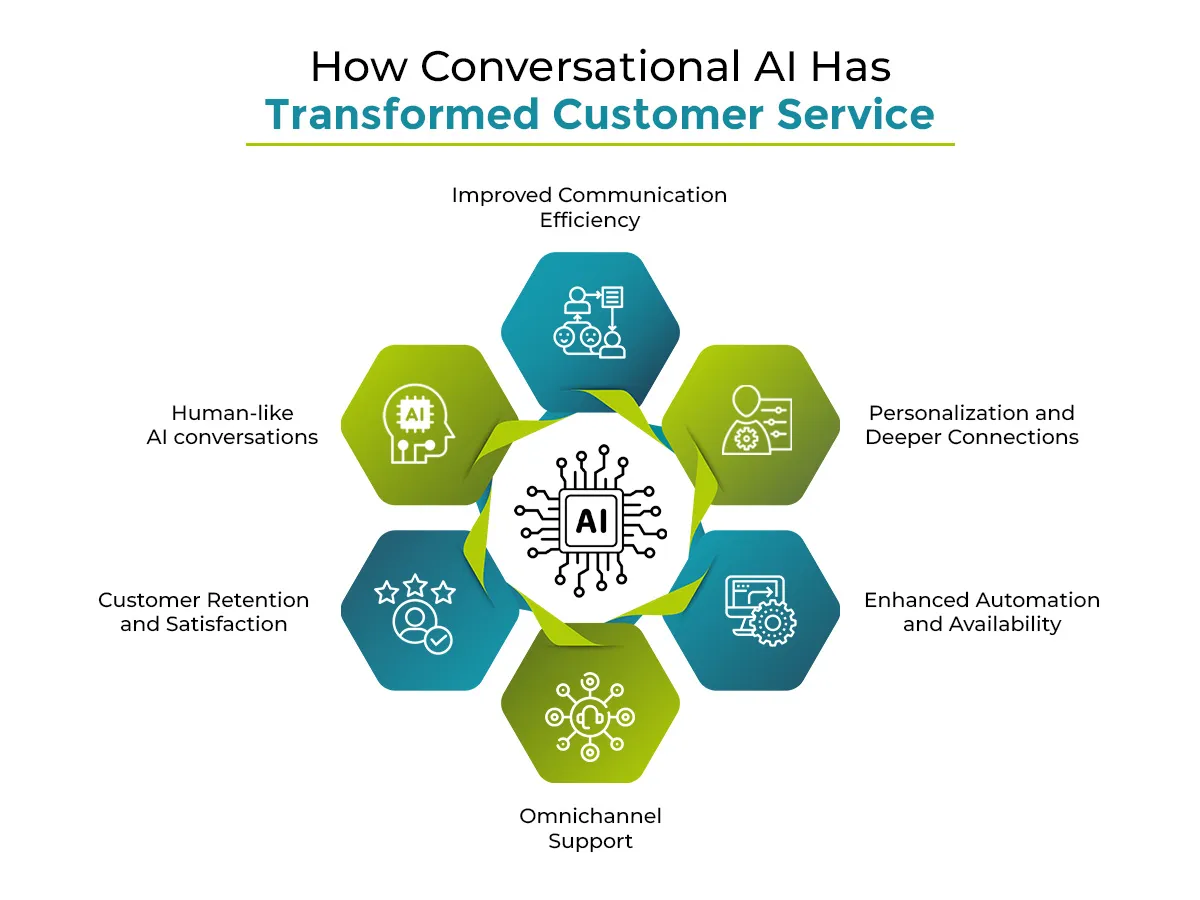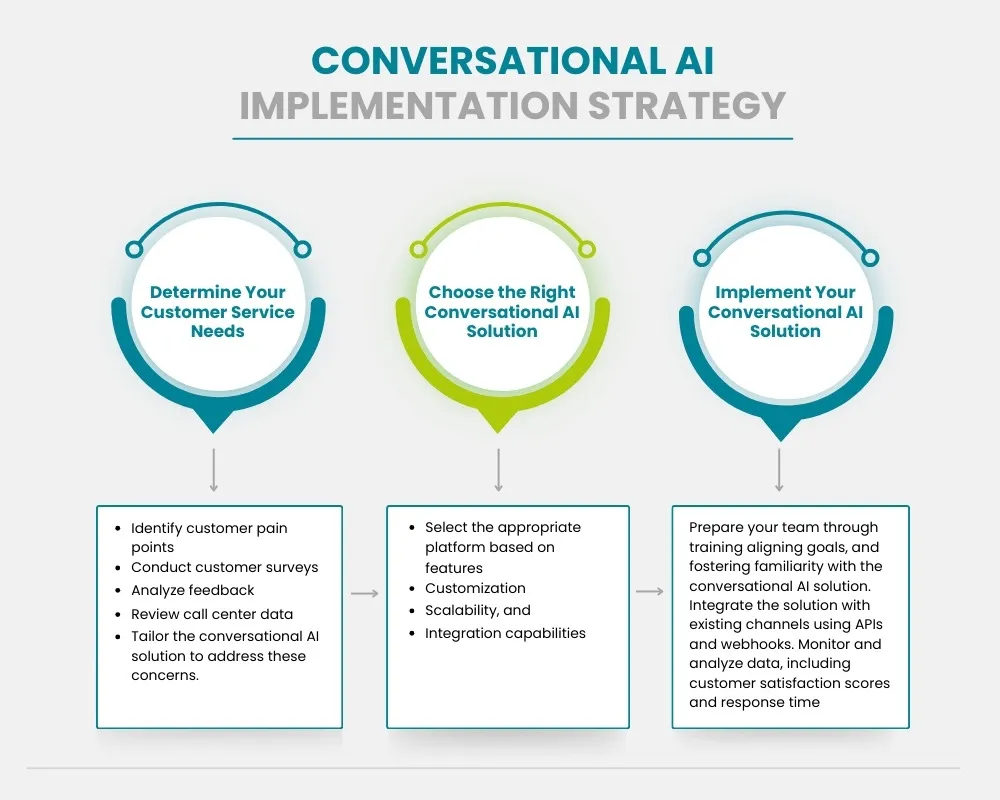
Traditional contact centers grapple with numerous challenges, including long wait times, inconsistent service quality, and difficulty handling complex queries. These issues contribute to diminishing customer satisfaction and loyalty.
As customer expectations evolve, there is a growing demand for personalized, efficient, and real-time interactions. Modern customers expect businesses to anticipate their needs and provide seamless support across various channels.
To stay competitive, contact centers must embrace innovation. Adopting advanced technologies, such as conversational AI, has become crucial to address current challenges and meet evolving customer expectations.
What is Conversational AI?
Conversational AI is a technology that enables machines to understand and respond to natural language in a humanlike manner. These technologies use Natural Language Processing (NLP), machine learning, speech-to-text, dialogue management, speech recognition, and intent recognition to enable human-like interactions.
CX leaders are deploying it for chatbots, IVRs, voice assistants, and virtual agents while supporting human agents to perform.
The need for these technologies is emerging due to several factors, including staff shortages, preference for fast, convenient, and knowledgeable assistance, and surging labor costs.
Evolution Of Traditional Customer Service with Conversational AI

By 2030, the global market for conversational AI is projected to reach $32.62 billion – source
– Statista
Customer service has evolved significantly with Conversational AI, driven by advancements in artificial intelligence and natural language processing technologies.This evolution has brought about several key changes and improvements:
Improved Communication Efficiency
Conversational AI, driven by NLP, facilitates natural interactions between customers and AI, marking a paradigm shift from traditional systems like VA and IVR.
Personalization and Deeper Connections
Conversational AI adapts to user information, fostering a deeper connection between businesses and customers through a personalized approach, ultimately enhancing the overall customer experience.
Enhanced Automation and Availability
AI-powered chatbots and virtual assistants have replaced traditional call centers, offering 24/7 customer support. Automation of routine tasks, like answering FAQs, has streamlined processes, enhancing efficiency.
Omnichannel Support
As consumers embrace AI-powered support tools, there is a growing demand for a seamless omnichannel experience. Conversational AI is utilized on various digital platforms, including messaging apps and e-commerce platforms.
Customer Retention and Satisfaction
Customers increasingly favor engaging with virtual assistants for product or service inquiries. Providing exceptional service through Conversational AI is vital for customer retention and satisfaction.
Evolution of AI Technologies
The evolution of Conversational AI introduces advanced systems like Dialog Bots, Intelligent Agents, Conversational Assistants, and Conversational Bots. These sophisticated technologies provide complex interactions, human-like conversations, and the capability to remember and recall customer information.
Understanding the Core Components of Conversational AI
Conversational AI is constructed upon two pivotal pillars of artificial intelligence: Natural Language Processing (NLP) and Machine Learning (ML).
Natural Language Understanding (NLU)
NLP helps computers and humans communicate naturally. It includes Natural Language Understanding (NLU), which analyzes speech for context and meaning, and Natural Language Generation (NLG), allowing machines to respond conversationally using structured data.
Additionally, Generative AI, like in applications such as ChatGPT, uses Large Language Models (LLM) to converse and create different types of content naturally. It relies mainly on Natural Language Generation (NLG) to respond to user prompts.
Together, NLU, NLG, and generative AI are the essential building blocks for meaningful interactions between people and machines.
Machine learning(ML)
Complementing NLP, ML adds significant value by continuously learning and improving its output with minimal human involvement.
In conversational AI, ML empowers computer applications to leverage insights from previous conversations and additional data, delivering more refined responses without requiring extensive programming.
In the process of creating a realistic conversation, a user’s question is input through an AI-powered app’s UI.
Whether spoken or typed, the computer utilizes speech-to-text or Automatic Speech Recognition (ASR) to digitize the language.
The computer then parses and segments the request, applying NLU to grasp the question’s context and meaning.
Machine learning comes into play, considering how similar questions have been addressed previously, assessing their usefulness and potential for follow-up questions.
Finally, the computer employs NLG and/or Generative AI to craft interview tips using relatable human language, completing the process of generating a user-friendly and contextually relevant response.
Benefits of Integrating Conversational AI
Since 71% of customers would prefer to interact with a chatbot than talk to a customer service agent, the right time to invest in conversation AI is now!
Did you know that using chatbots for customer service can save companies up to 4 minutes per question, costing only $0.70 per interaction?
Let’s explore more such benefits of integrating conversational AI:
Optimal Data Collection
Leverage lead and customer data efficiently with advanced conversational AI, which transcribes conversations, making them searchable for insights and trend spotting.
Higher Efficiency
Conversational AI enhances efficiency by handling tasks without human intervention, allowing employees to focus on personalized customer satisfaction and scalable management processes.
Better Cost-efficiency
Independently automated, conversational AI slashes operating costs by efficiently handling tasks that might be time-consuming for human agents, such as tracking calls, analyzing engagement, and reducing the chance of human error.
Improved Customer Experience
Enhance customer experience through easy communication, personalized interactions, and 24/7 availability, accommodating customers in different time zones.
Increased Accessibility
Conversational AI, being omnichannel, allows customers to interact through their preferred medium, providing instant answers and skipping long phone queues, thus increasing accessibility.
Personalization
Utilize advanced conversational AI technology, powered by machine learning, to create personalized chat experiences for each customer, resolving queries efficiently and reducing the need for multiple contacts.
Conversational AI Use Cases

Conversational AI offers diverse applications for businesses, transforming customer engagement and operational efficiency. Key use cases include:
Elevating Business-Customer Interactions
Conversational AI enhances customer interactions with personalized responses, creating engaging experiences across communication channels. It anticipates needs, offering information or offers proactively, maintaining seamless context.
Streamlining Support With Automation
Conversational AI streamlines support in contact centers by automating ticket creation and routing. Self-service options empower customers with common queries, reducing reliance on human agents. The system intelligently escalates complex issues to human agents, ensuring tailored support for each customer.
Gaining Customer Insights
Conversational AI deployment gives businesses deep insights into customer sentiment, satisfaction, and trends through sentiment analysis. It identifies preferences, offering valuable data for strategic decision-making. Real-time feedback mechanisms enable continuous process refinement based on customer input.
Transcription Accuracy and Insights
Conversational AI significantly contributes to accurate transcriptions during support calls, enabling meticulous record-keeping for understanding customer interactions and extracting valuable business insights. These precise transcriptions aid in maintaining compliance and contribute to robust audit trails, ensuring transparency and accountability.
Redefining Chatbots and IVRs
Conversational AI transforms automated CX systems by adding NLU capabilities to chatbots and IVRs, enabling them to understand and respond human-likely. Dynamic scripting adjusts responses based on business and customer needs, and continuous learning ensures AI-driven chatbots evolve, improving accuracy and relevance with each interaction.
Challenges and Solutions
While implementing conversational AI, challenges like the complexity of natural language understanding (NLU), user intent recognition, and effective communication can be barriers. Let’s explore these hurdles and best practices for effectively implementing Conversational AI for improved customer interactions and operational efficiency.
Challenges Faced by Conversational AI Technology
NLU Complexity
Implementing Natural Language Understanding (NLU) is challenging due to the intricacies of human language and privacy concerns with data collection.
Understanding User Intents
Recognizing user intents and context is difficult, especially across diverse languages and dialects.
Communication Issues
Language barriers pose challenges, requiring consideration for successful communication.
Costly Investment
Development and maintenance of Conversational AI can be expensive due to complex technologies and ongoing data processing.
Privacy Concerns
Heavy reliance on user information raises privacy and security worries among consumers.
Public Skepticism
New technologies often face public skepticism, requiring time for full adoption.
Unexpected Questions
Chatbots may struggle with unanticipated customer queries, necessitating quick understanding for accurate responses.
Best Practices for Conversational AI Technology
Establish Clear Goals
Define goals for Conversational AI integration to align efforts and accurately evaluate success.
Understand Target Audience
Acquire insights into user needs, preferences, and expectations for tailored experiences.
Select Appropriate Technology
Consider factors like natural language processing, machine learning, and scalability for effective integration.
Design Engaging User Experience
Create an enjoyable user experience with a simple, user-friendly interface and accurate intent understanding.
Ensure Accuracy and Robustness
Test with real user data to ensure accurate responses and robust handling of unexpected inputs.
Design Effective System
Consider components like NLP, context tracking, and memory retention for a comprehensive conversational AI system.
Maintain Data Privacy
Implement measures to secure user information and explain its usage in compliance with privacy standards.
Prioritize Error Handling
Anticipate potential issues, design error recovery strategies, and offer human support options for a seamless user experience.
Implementation and Integration Strategy

Conversational AI has been transformative in customer service. It can completely enhance how your business interacts with customers, providing faster response times, increased efficiency, and improved customer satisfaction.
Let’s discuss how you can implement conversational AI to handle customer service operations.
Step 1: Determine Your Customer Service Needs
Identify customer pain points and common issues by conducting customer surveys, analyzing feedback, and reviewing call center data. Tailor the conversational AI solution to address these concerns.
Step 2: Choose the Right Conversational AI Solution
Select the appropriate platform (e.g., chatbots, virtual assistants, voice-enabled devices) based on features, customization, scalability, and integration capabilities. Ensure seamless integration with existing customer service channels.
Step 3: Implement Your Conversational AI Solution
Prepare your team through training, aligning goals, and fostering familiarity with the conversational AI solution. Integrate the solution with existing channels using APIs and webhooks. Monitor and analyze data, including customer satisfaction scores and response times, to continuously improve the AI system and meet customer needs.
At Vsynergize, we have the solutions to propel your business forward. Our Conversational Intelligence solutions are strategically crafted to equip your business with actionable insights and drive remarkable results.
Future Trends in Conversational AI for Customer Service
A recent Gartner report forecasted that by 2025, 80% of customer service and support companies will incorporate generative AI to enhance agent productivity and the overall customer experience.
Another Gartner poll revealed that 38% of surveyed leaders prioritize enhancing customer experience (CX) and customer retention as the primary goals for initiatives involving large language models (LLMs).
Let’s explore the Conversational AI trends that will transform customer service in the near future.
- Conversational AI (chatbots) is rapidly advancing in various industries.
- Future predictions include the rise of low-code development, simplifying creation without advanced coding skills.
- Enhanced personalization will focus on expert guidance and tailored user experiences.
- AI chatbots are evolving for more natural conversations through improved emotional intelligence and sentiment analysis.
- The COVID-19 pandemic has accelerated conversational AI adoption, especially for valuable customer service with multilingual capabilities.
- Conversational AI is expected to play a crucial role in advisory functions, aiding decision-making and reducing errors.
- Innovations in voice assistant technology targeting challenges like accent variations and background noise for improved accuracy.
- The future of conversational AI envisions a truly omnichannel experience, emphasizing a unified and strategic customer journey across all channels.
Conclusion
Conversational AI is reshaping customer service, overcoming traditional challenges with advanced technologies like Natural Language Processing and Machine Learning. It enhances communication efficiency, personalization, and overall customer satisfaction. Despite challenges, adherence to best practices ensures successful integration.
Looking forward, trends like enhanced personalization, advisory functions, and a truly omnichannel experience are shaping the future of Conversational AI. Businesses strategically leveraging these advancements are set to engage, assist, and delight customers, fostering lasting relationships and driving sustainable growth.
At Vsynergize, we are more than just a service provider; we are your strategic partner in harnessing the power of conversational intelligence. Our solutions are strategically crafted to equip your business with actionable insights and drive remarkable results.
Discover Our Suite of Conversational Intelligence Solutions at Vsynergize!



